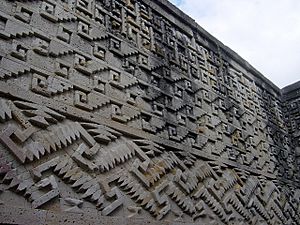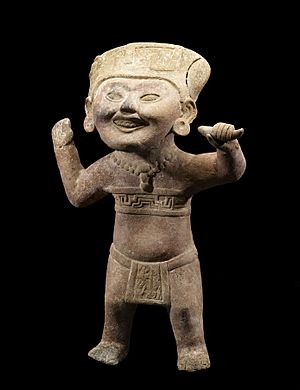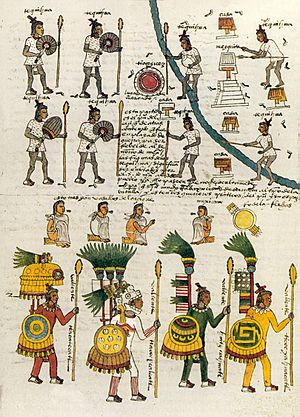Xicalcoliuhqui facts for kids
The Xicalcoliuhqui (say "shee-kal-koh-lee-OO-kee") is a famous design often seen in Mesoamerican art. You might also hear it called a "step fret" or "stepped fret" pattern. It looks like a zigzag line with steps and a hook or spiral at the end, a bit like a "Greek key" design.
People in ancient Mesoamerica used this pattern on many things. You can find it on jewelry, masks, pottery, statues, and even on clothes made with feathers. It was also painted on walls, in old books called codices, and on buildings. This design has been used for a very long time, from ancient times right up to today.
Contents
What Xicalcoliuhqui Means
The word xicalcoliuhqui comes from the Nahuatl language. It means "twisted gourd." A gourd is a type of fruit with a hard shell, often used as a bowl.
This design has many different meanings. Some people think it shows water, waves, or clouds. Others believe it represents lightning or a snake, like the mythical Feathered Serpent. It might also stand for ideas like things moving in a circle, or the important connection between the sun's light and the Earth. Some even thought it could protect against death. However, no one meaning is agreed upon by everyone.
It's also possible the design looks like a cut conch shell. The conch shell is a symbol for Ehecatl, the wind god, who is a form of Quetzalcoatl. It seems that having so many possible meanings made this symbol very powerful and long-lasting.
Xicalcoliuhqui Chimalli: The Stepped-Fret Shield
A xicalcoliuhqui chimalli (say "chee-MAH-lee") is a type of shield. These shields have a single xicalcoliuhqui design on them. They were often painted or covered with beautiful feathers.
You can see these shields in many old Mexican books, especially the Codex Mendoza. The xicalcoliuhqui design on these shields is usually shown in yellow and green colors.
Xicalcoliuhqui on Buildings
The xicalcoliuhqui design was also used to decorate temples and other buildings at ancient sites across Mexico.
- At El Tajín in Veracruz, you can see the xicalcoliuhqui pattern on both sides of the stairs of The Pyramid of the Niches.
- At Mitla, an ancient Zapotec site in Oaxaca, the stone mosaics show many different versions of the xicalcoliuhqui pattern.
Gallery









